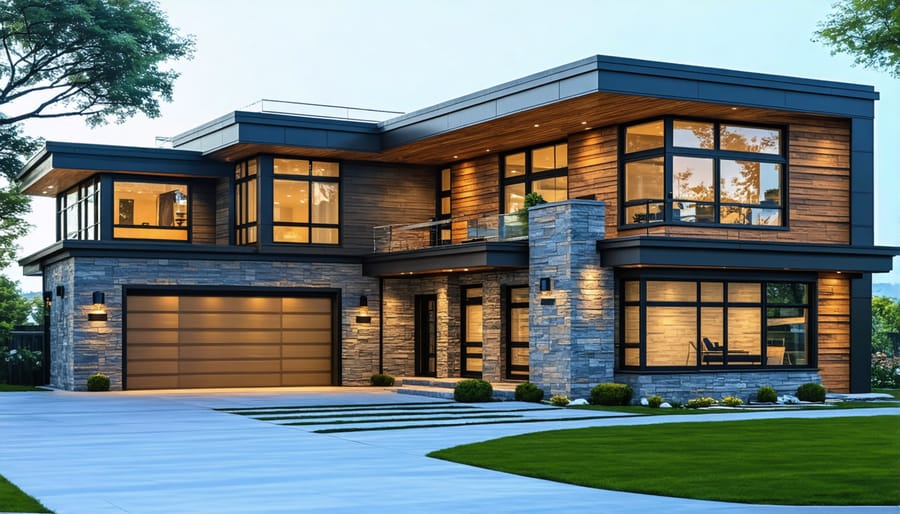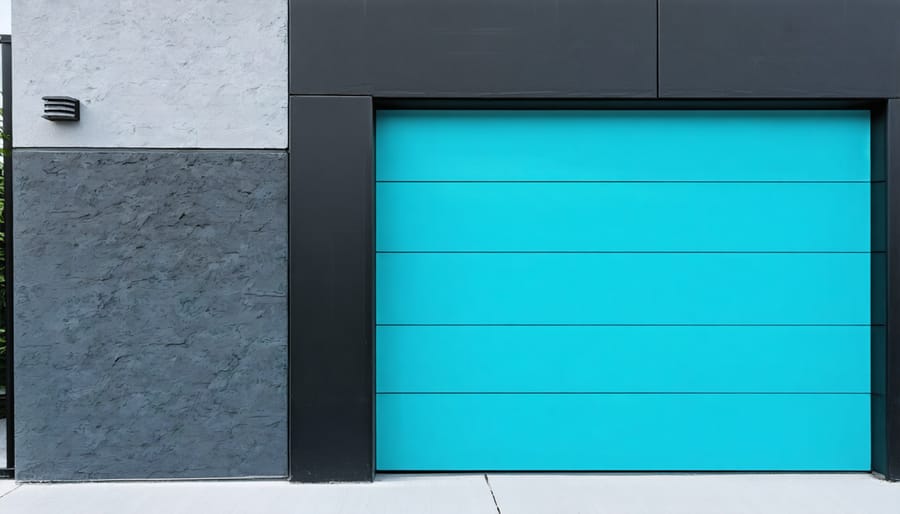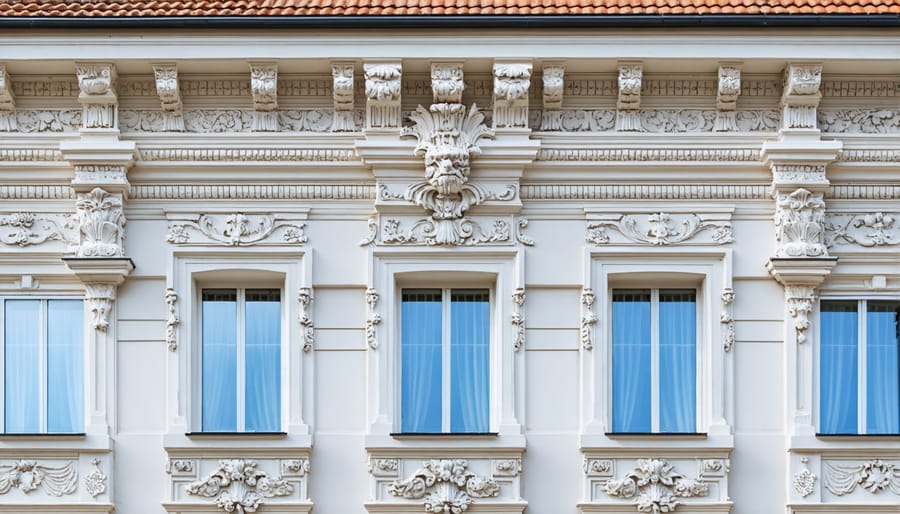Transform your home’s exterior from ordinary to extraordinary with innovative wall designs that make a lasting impression. Today’s architectural trends blend bold textures, sustainable materials, and creative patterns to create facades that captivate and inspire. Whether you’re planning a complete renovation or seeking subtle updates, mastering these exterior design secrets can dramatically enhance your property’s curb appeal and value.
From contemporary mixed-material combinations like stone and wood to classic brick patterns with modern twists, the possibilities for exterior wall transformation are endless. Smart material choices not only define your home’s character but also provide essential protection against weather elements while reducing maintenance needs. Consider how natural light plays across different textures throughout the day, and explore how architectural elements like geometric patterns or vertical gardens can create visual interest that sets your home apart in the neighborhood.
Modern Materials That Make a Statement
Mixed Material Magic
Gone are the days of single-material exteriors! Today’s most striking home facades embrace the art of mixing materials to create eye-catching visual interest and depth. By combining different textures and surfaces, you can craft a unique exterior that stands out while maintaining harmony with your neighborhood’s aesthetic.
Consider pairing smooth stucco with rustic stone accents, or combining warm cedar siding with sleek metal panels. Natural stone veneer can work wonders when used alongside modern fiber cement boards, creating a perfect balance between traditional and contemporary elements. For a bold statement, try incorporating weathered wood planks with industrial corrugated metal – the contrast alone becomes a conversation starter.
The key to successful material mixing lies in choosing complementary colors and textures. Start with a dominant material that covers 60-70% of your exterior, then add secondary and accent materials for visual interest. For instance, a primarily brick facade can be elevated with wood trim details and metal accent walls.
Don’t forget about practical considerations – each material should be suitable for your climate and maintenance capabilities. Strategic placement matters too; use durable materials at ground level where exposure to moisture is highest, and consider how different materials will age together over time.
Pro tip: Before finalizing your design, create a small mock-up board with your chosen materials to ensure they work well together in natural lighting.

Sustainable Solutions
As homeowners become increasingly environmentally conscious, sustainable exterior wall solutions are gaining popularity. These eco-friendly design options not only reduce your carbon footprint but also create stunning visual appeal.
Reclaimed wood siding offers a rustic charm while giving new life to existing materials. The natural weathering process creates unique patterns and textures that tell a story, making each installation truly one-of-a-kind. Consider treating it with eco-friendly sealants to enhance durability without compromising sustainability.
Living walls or vertical gardens transform ordinary exterior surfaces into lush, green masterpieces. These biodiverse installations provide natural insulation, improve air quality, and create a striking visual impact that changes with the seasons. They’re particularly effective in urban settings where green space is limited.
Cork cladding is another innovative option, offering excellent insulation properties and natural resistance to mold and pests. Its unique texture adds warmth and character to modern designs while being completely renewable and biodegradable.
Recycled metal panels provide a contemporary look while repurposing materials that might otherwise end up in landfills. When properly treated, they develop an attractive patina over time and require minimal maintenance. For a more traditional appearance, consider sustainable composite materials that mimic natural stone or wood while offering superior durability and environmental benefits.
Color and Texture Combinations That Work
Bold Color Strategies
Bold colors can transform your home’s exterior from ordinary to extraordinary, making a dramatic statement that helps enhance your home’s entrance and overall curb appeal. When using vibrant hues on exterior walls, start by considering your home’s architectural style and the surrounding environment. Mediterranean-style homes can beautifully showcase deep terracotta or sun-washed yellows, while modern designs often pop with dramatic charcoal or navy blue.
For maximum impact, try the 60-30-10 rule: use your bold color on 60% of the exterior (main walls), a complementary color on 30% (trim and architectural details), and an accent color on 10% (doors and shutters). This creates a balanced, cohesive look that won’t overwhelm the neighborhood.
Test your color choices with large sample patches on different sides of your house, observing how they appear in various lighting conditions throughout the day. Remember that bold colors can appear more intense on large surfaces, so consider going one shade lighter than your initial choice.
To ensure your bold color choice stands the test of time, invest in high-quality exterior paint with UV protection. This prevents fading and maintains your home’s striking appearance for years to come. If you’re hesitant about committing to an all-over bold color, try using it on an accent wall or architectural feature first. This allows you to make a statement while maintaining a more neutral overall palette.

Textural Elements
Texture is a powerful design element that can transform a plain exterior wall into a captivating focal point. By combining different materials and surface treatments, you can create depth and visual interest that makes your home stand out in the neighborhood.
Consider incorporating natural stone elements, which add rugged character and timeless appeal. Whether it’s a full stone facade or accent sections, the varied textures of materials like slate, limestone, or river rock create stunning shadow play throughout the day.
Wooden elements bring warmth and organic texture to your exterior walls. Traditional wood siding, modern cedar panels, or decorative wooden screens can be mixed with smooth surfaces for striking contrast. For low-maintenance alternatives, wood-look fiber cement products offer similar texture without the upkeep demands.
Brick patterns provide endless possibilities for textural variety. Try mixing traditional running bond with decorative herringbone sections, or combine different brick colors and sizes to create visual rhythm. For modern homes, consider using thin brick tiles or textured concrete panels that mimic industrial materials.
Don’t overlook the power of architectural details like board-and-batten siding, corrugated metal panels, or dimensional tile work. These elements not only add texture but can also help define different zones of your home’s exterior.
For subtle texture, explore techniques like smooth stucco with sand finish, vertical groove panels, or raised geometric patterns. These options add interest without overwhelming the overall design, perfect for contemporary homes seeking sophisticated detail.
Architectural Accents
Trimwork and Moldings
Trimwork and moldings can transform a plain exterior wall into an architectural masterpiece. These decorative elements add depth, character, and visual interest while increasing your home’s curb appeal. Consider installing crown molding along the roofline, elegant corner boards, or detailed window casings that complement your window replacement considerations.
For a classic look, combine wide baseboards with mid-height chair rails or add dentil molding beneath the eaves. Colonial-style homes benefit from fluted pilasters flanking entryways, while craftsman-style houses shine with chunky, exposed rafter tails and decorative brackets.
When selecting trim materials, weather-resistant options like cellular PVC, fiber cement, or treated wood ensure longevity. These materials resist rot, insects, and moisture while maintaining their appearance for years. Paint your trim in contrasting colors to make architectural details pop – white trim against darker siding is a timeless choice that never goes out of style.
Pro tip: Before installation, consider the scale of your trim elements. Oversized moldings can overwhelm smaller homes, while minimal trim might get lost on larger facades. Take measurements and use painter’s tape to mock up designs, helping you visualize the final look before making permanent changes.
Remember to maintain proper spacing and symmetry when planning your trim layout. This attention to detail will create a cohesive, professionally designed appearance that enhances your home’s overall aesthetic value.

Feature Walls
Feature walls can transform your home’s exterior from ordinary to extraordinary by creating a stunning focal point that captures attention. Consider incorporating natural stone veneer for a timeless, elegant look that adds texture and dimension. The varying colors and patterns in stone create visual interest while maintaining a sophisticated appearance.
For a modern twist, vertical wood siding installed on a single wall section can provide warmth and natural beauty. Choose weather-resistant woods like cedar or treated pine, and consider different installation patterns such as horizontal, diagonal, or chevron designs to make your feature wall truly unique.
Metal panels offer another contemporary option, with materials like corrugated steel or copper bringing industrial chic to your home’s exterior. These materials can develop beautiful patinas over time, adding character to your design. For bold personalities, consider using decorative tiles or mosaic patterns to create an artistic statement wall that reflects your style.
Living walls are gaining popularity as feature elements, incorporating plants and greenery into vertical gardens. These eco-friendly options not only look stunning but also provide natural insulation and improve air quality around your home.
Remember to consider your home’s overall architectural style when selecting a feature wall treatment. The key is to create contrast while maintaining harmony with existing elements. Proper lighting can enhance your feature wall after dark, making it a focal point both day and night.
Practical Considerations
Weather Resistance
When designing your home’s exterior walls, considering your local climate is absolutely crucial for long-term durability and maintenance. Different weather conditions demand different materials and protective measures to ensure your exterior walls stand the test of time.
In areas with heavy rainfall, opt for water-resistant materials like fiber cement siding or vinyl, and ensure proper drainage systems are incorporated into the design. Include adequate overhangs and flashing to direct water away from your walls. For coastal regions, choose materials specifically rated for salt spray resistance, such as treated wood or specialized metal cladding.
If you live in an area with extreme temperature fluctuations, consider materials with good thermal expansion properties, like engineered wood or composite materials. These help prevent cracking and warping during seasonal changes. For hot, sunny climates, light-colored materials and heat-reflective coatings can help reduce heat absorption and protect your walls.
Don’t forget about proper insulation and vapor barriers – they’re essential in any climate. In humid regions, ensure your design includes adequate ventilation to prevent moisture buildup. For areas prone to high winds, secure attachment methods and impact-resistant materials are must-haves.
Remember to check local building codes and regulations, as they often specify minimum requirements for weather resistance based on your specific location. Working with a local contractor who understands regional weather patterns can help ensure your exterior wall design withstands whatever Mother Nature throws at it.
Maintenance Requirements
Keeping your exterior walls looking their best requires regular maintenance, but the level of upkeep varies significantly depending on your chosen design and materials. Vinyl siding typically needs annual cleaning with soap and water, while brick walls may require occasional repointing every 20-30 years to maintain structural integrity.
For painted surfaces, plan on repainting every 5-7 years, though this timeline can vary based on your climate and sun exposure. Metal cladding generally needs minimal maintenance beyond periodic cleaning and checking for loose fasteners, making it an excellent low-maintenance option.
Natural stone walls are incredibly durable but should be sealed every 2-3 years to prevent water damage and staining. Wood siding demands the most attention – plan on refinishing or resealing every 2-4 years and regular inspections for rot or pest damage.
Quick maintenance tips for all exterior walls:
– Conduct visual inspections twice yearly
– Clean surfaces annually to prevent buildup
– Address any cracks or damage promptly
– Keep vegetation trimmed away from walls
– Ensure proper drainage to prevent water damage
– Check caulking and weatherstripping annually
Remember, investing time in regular maintenance helps prevent costly repairs and keeps your exterior walls looking fresh. Consider your available time and maintenance budget when selecting your wall design, as some materials require significantly more attention than others.
Transforming your home’s exterior walls is more than just a renovation project – it’s an opportunity to express your personal style while increasing your property’s value and curb appeal. From the timeless charm of natural stone to the modern allure of mixed materials, the design possibilities we’ve explored offer something for every taste and budget.
Remember that successful exterior wall design balances aesthetics with practicality. Consider your local climate, maintenance requirements, and architectural style when making your choices. Don’t be afraid to mix textures, experiment with colors, or incorporate sustainable materials to create a unique look that reflects your personality while remaining timeless.
Whether you’re planning a complete exterior makeover or looking to refresh a single wall, start by gathering inspiration, consulting with professionals when needed, and creating a detailed plan that accounts for both your vision and practical constraints. Pay special attention to material durability, weather resistance, and long-term maintenance needs to ensure your investment stands the test of time.
Now that you’re equipped with these creative ideas and practical considerations, it’s time to take the first step toward transforming your home’s exterior. Start small if you’re unsure, and remember that even minor changes can make a significant impact on your home’s overall appearance. Your dream exterior awaits – begin your transformation journey today!
